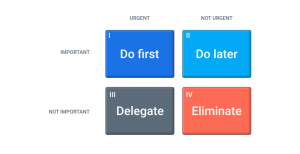Here’s the thing: your brand identity and how you create it matters – in a big way. It matters to your long-term eCommerce success, to conversion success, for increasing your repeat customer rates, and if you want to stand out from your biggest competitors. But where to start?
If you are looking for leading strategies on how to create a brand identity and take your eCommerce brand to expert status, you’ve come to the right place. But before we dive into our top 9 eCommerce branding strategies, let’s look at what brand identity is and why it is so important.
Branding is more than just your store logo or name. It’s a mix of feel, tone, and vibe – the voice of your brand. The voice you use to communicate to your specific customers through your products, marketing, policies, copywriting, content marketing, communication, checkout pages and flow, email marketing, the store’s look and feel, lifestyle and product pages, and your overall web presence.
It’s the ‘human’ voice and vibe of your brand, how your eCommerce store is perceived by your target audience, your store’s personality, your competitive advantage – and it’s the secret to growing a million-dollar eCommerce brand. This is something that Man Crates really gets. Here’s just a taste of their copy, product names, micro-copy, and product options.



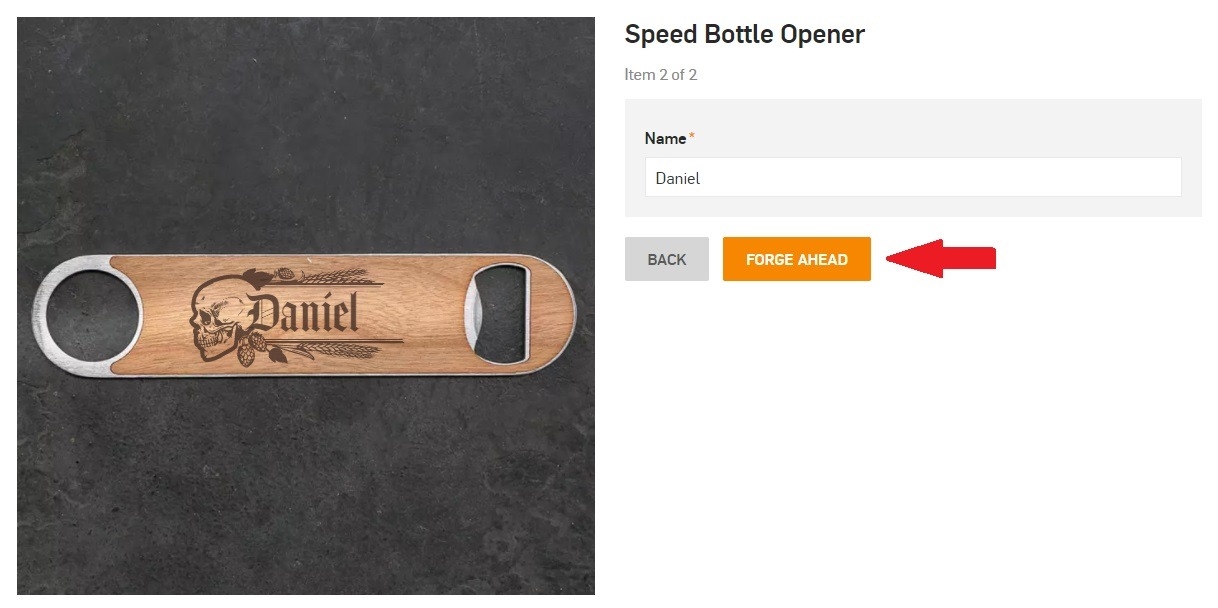
Branding and identity are powerful tools, yet so many online stores put branding strategy at the bottom of their to-do lists in terms of time and budget. The thing is, without investing the effort and money into creating a robust and compelling brand identity, it is almost impossible to grow your business long-term.
In short, it’s the first impression a potential shopper is going to get – the way you connect with them throughout the buying process: speaking their language, and what drives them to not only convert once but become a loyal customer. AKA sustainable growth.
As powerful as it is, this growth doesn’t come easily. It is something that even experienced eCommerce entrepreneurs struggle with, as it’s not one tangible thing you can optimize and measure; it involves every aspect of your store. To help assess and upgrade your brand identity, here are 9 eCommerce branding strategies to implement.
eCommerce Branding Strategy #1: Get to Know Your Target Audience Inside and Out
It is easy to want to cast a wide net to drive eCommerce conversion rates. However, when creating a sound brand identity, you need to define your key target market and focus exclusively on them. It’s the building block to defining everything else. Additionally, it gives you a way to naturally resonate with potential shoppers; fully understand their needs, wants, and desires; and speak their language – everything needed for strengthening your eCommerce branding. In short, you can’t build your brand persona if you don’t fully understand who you’re building it for. Even if you did in-depth target market research before you started your online store, you need to continuously re-assess who your shoppers are and tweak your branding and customer journey messaging.
What to Do: Shopper and Customer Analysis
To get a clear understanding of precisely who you are targeting and your existing customers, you will want to do a target audience analysis. Here are some expert tips to get you started:
- Speak directly to your market by sending surveys to potential customers on your mailing lists, doing personal interviews with your most loyal customers, and conducting focus groups with potential customers who match your ideal customer specs.
- Be as specific as possible when assessing personality/lifestyle. This means drilling down the finer details of your potential shoppers and existing customers, and includes attitudes, pain points, passions, and beliefs.
- Create detailed customer profiles and potential customer market segments, including characteristics. Start with demographic data such as location, age, income, and occupation and then split by psychographic data such as interests, attitudes, lifestyle preferences, and hobbies.
- Study your competitors’ marketing positioning, pricing, customer comments, communication on social media, and reviews.
eCommerce Branding Strategy #2: Lay a Strong Foundation with the Four Vs of Branding
The most essential elements of creating brand identity are the four Vs: they will set the tone and guidelines for every other aspect of your eCommerce brand and business. Think of them as the foundation or the four pillars your whole eCommerce business will stand on – the things that will influence other branding decisions. They are vision, voice, values, and variation and will help you keep every area of your eCommerce business focused. They are quite literally your roadmap to long-term branding and business success. Let’s look at each of them in detail.
1. Vision
Your brand vision is the major goal you have for your eCommerce business, and it’s how you set yourself up to attract customers. It may be time to review and redefine your business vision. You can do this by going back to the beginning and looking at what inspired you to launch your store in the first place – beyond the goal of making profits. Additionally, take a good look at your products. What pain or passion did you set out to solve with your products? How do your customers feel or what do they think long after they have bought and used your products?
2. Voice
Voice is one of the most important steps of defining and creating your brand. Just as it’s vital to determine who you are talking to, it’s equally important to decide how you will speak to them. It’s the personality of your brand; how your brand distinguishes itself from the competition and talks directly to customers. It should be consistent throughout your entire shopping journey and humanize your brand. Some examples include:
- Friendly
- Sophisticated
- Helpful
- Fun and playful
- Authoritative
- Funny
As imperative as finding your brand voice is, it is so often overlooked. Here are steps you can follow to help you define your own eCommerce voice:
- Review your mission statement and vision
- Create a simple customer survey to determine how they see your brand and what they feel about your current tone
- Search for common themes in your current messaging and tone, and ensure they fit your brand values, vision, and purpose
- Ask yourself: If your brand was a person, what would it be like?
- Do an in-depth study of your five most loyal customers
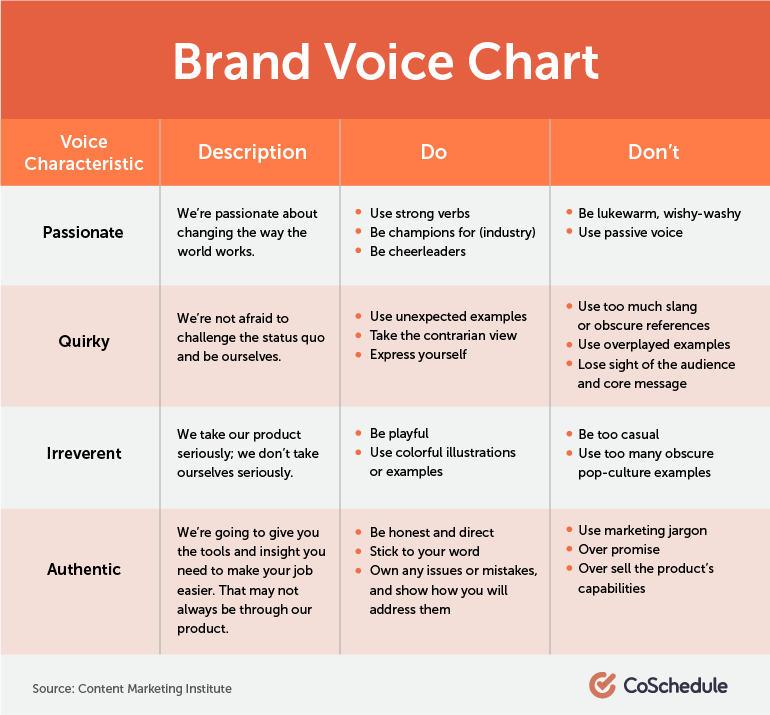
Remember: your brand voice doesn’t need to be dramatic to be effective. Above all else, it should come across as authentic, not forced. Missguided, for example, manages to be a bit cheeky and rebellious (not in an over-the-top way) – which speaks to their younger target audience – across their site, product pages, shopping journey, customer service, and social media posts and replies.
3. Values
The third V is values. Values are what your eCommerce business’s main priorities are, and should guide everything you do in your business. They take your target market, vision, and voice and clearly set out your brand ethos. See the ‘description’ section in the brand voice chart above; it has some good examples of how to define your eCommerce business’s values.
4. Variation
The last V is variation – what sets you apart from every other business. Is it price or exclusivity? Is it local, such as beach gear, or the first of its kind? Determining your variation will help with messaging across all the shopping stages of your store and marketing campaigns. Simply put, to find your distinguishing factor, ask yourself why a customer should buy your product instead of your closest competitor’s.
eCommerce Branding Strategy #3: Match Store Design to the Four Vs
Once you are sure you have a clear understanding of your values, variation, and vision, as well as a brand voice that embodies all of that, it’s time to ensure your eCommerce store’s visual branding matches them.
Let’s say your target market is female students who like the beach lifestyle. They are fun and playful, not looking for anything serious (corporate or political), and looking for affordable beachwear. Your brand voice is just that – fun and playful – and you’ve decided not to take yourselves (the brand) too seriously. If you are using colors and typography that don’t match that, or if your design is stuffy and suited to older professionals, you’re not only dramatically increasing the chances of your first impression bombing, but confusing potential shoppers. In short, you’ll be working much, much harder to get customers.
The three most important visual elements that help you translate your voice and values into images that are relatable to your audience include your logo, typography, and color. Here’s a short description of the importance of each:
- Your logo is the visual face of your brand. It should be simple, memorable, and match your tone.
- The colors you choose for your online store will elicit emotional responses. Therefore it is important that these emotional responses match your brand’s voice.
- Your chosen typography (fonts) is another style element that plays a big part in the overall impression your online store gives.
A good example of an eCommerce brand that nails all three is Ride Rich.

What to Do: eCommerce Store Design Audit
To ensure your overall store design matches the four Vs, you will want to perform a store design audit. Ask yourself: Do your current color scheme, typography, and logo convey your brand’s vision and messaging? Is the formatting of these elements consistent throughout your whole store and across all your marketing channels? Here are 28 Multimillion-Dollar Online Fashion Brands that are winning with store and marketing branding for inspiration.
eCommerce Branding Strategy #4: Use Copy to Speak Your Shoppers’ Language
The next eCommerce branding strategy for creating a strong business identity is evaluating your website copy and tweaking it to ensure it speaks your shoppers’ language. In other words, it is in line with your brand voice. This ensures that store copy emotionally connects with your customers and leaves a lasting impression. An eCommerce brand that understands how to write copy that speaks to their target market is BarkBox. Here are some examples from their home page.
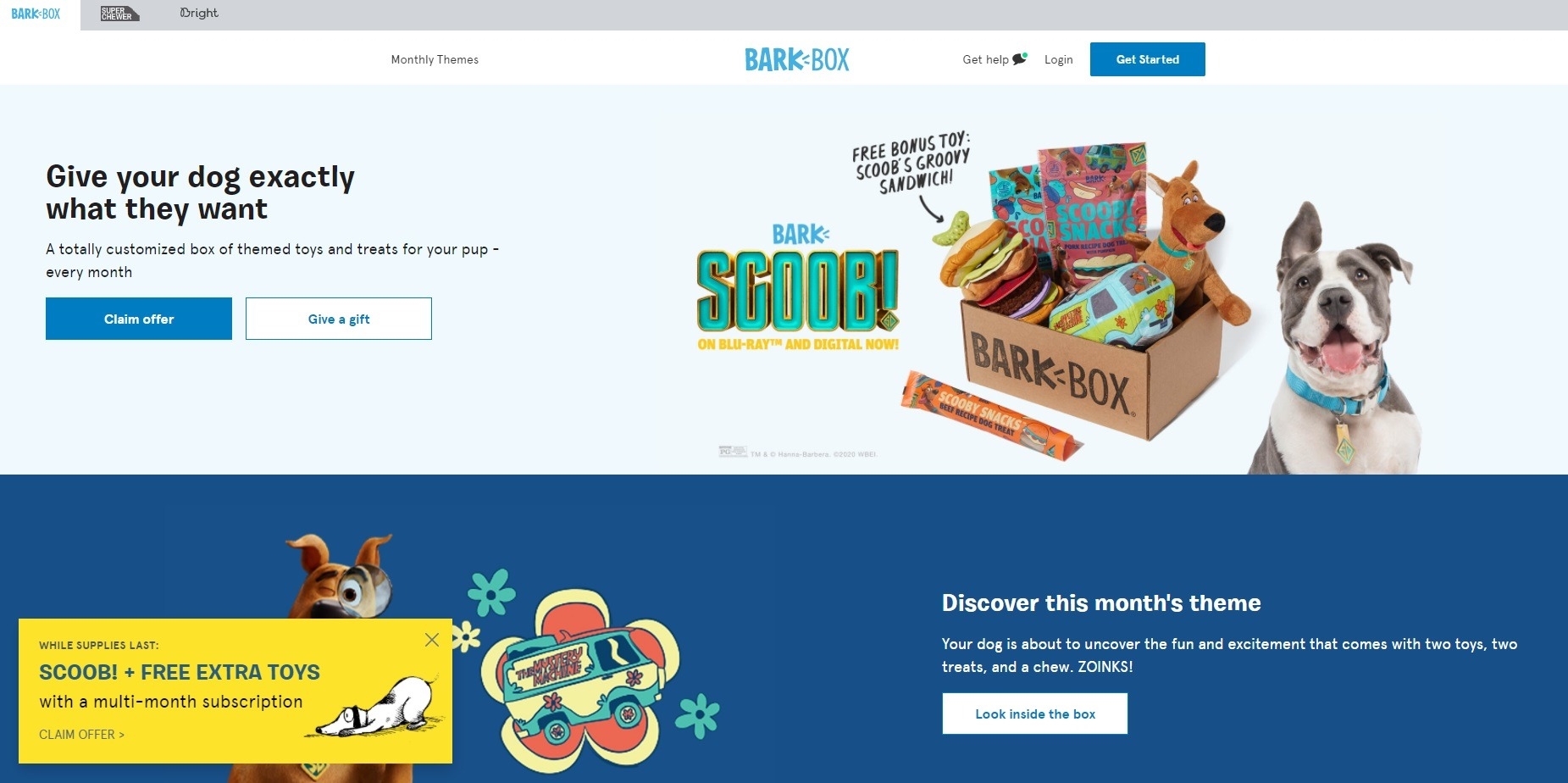
Speaking your target market’s language isn’t just about tone. Although that is also very important for ensuring your copy lines up with your voice, it’s about incorporating expressions and colloquial terms that resonate with your potential shoppers. This should be used when creating all your pages’ copy, micro-copy for buttons, marketing, customer service, and more. This can be as simple as ensuring you are using relevant slang.
Pro Tip: It’s important to create a copy style guide that you match consistently, even if you’re branching out to new markets. Let’s say you are selling posters online to the UK, and your brand uses colloquial terms, copy, grammar, and spelling that are appropriate for the UK market. But what if you decide to break into the US market and run a promotional campaign targeting the US? You’re not going to change your copy tone, vibe, and language – unless you plan on creating a whole separate web store for the new market. What you can do, though, is ensure your headline text and promotional landing page for that US-specific promotion are edited to the US market’s language – switching out your usual UK-related slang for American.
What to Do: Turn to Your Shoppers
To assess whether your copy lines up with your target shopper, you’ll want to scan your reviews, social post engagement, and customer communications for common expressions you could integrate into your copy. Additionally, turn to your customer and competitors’ research data, if possible, to see whether popular phrasing or terms come up.
eCommerce Branding Strategy #5: Prioritize Customer Service
Customer service branding, voice, and tone are very often overlooked. However, they play a crucial role in developing your brand identity. Therefore, if you are not looking for ways to serve your shoppers better, you’re missing out on one of the most valuable branding strategies. This means keeping your customers’ wants and needs at the center, adapting your customer journey to appeal directly to them, and engaging with customers throughout these stages. You also want to ensure you separate your customers into segments for marketing and on site to allow for more personalization, which enforces your branding.
This isn’t just about dealing with onsite or product queries, but filtering through all communication channels, including social media engagement. An excellent example of a brand winning at keeping customer service personal is Little Party Dress.

For customer service inspiration, visit our 4 eCommerce Brands Taking Customer Service to the Max post.
What to Do: Upgrade Customer Service to Pro Level
This means you should be diving deeper into your customer data, assessing their experiences, and adapting as needed. Start by looking at purchase data such as your loyal customers, repeat purchase rates, and best-selling products to see who is sticking around and what they are buying. You will also want to take a hard, honest look at your customer feedback as well as the questions and comments from potential shoppers who didn’t end up buying. And remember – you want to answer every query.
With regards to segmenting your customers to fine-tune your customer service, you will want to segment your customer lists and study the data to see how you can personalize your shopping experience for these segments.
Which brings us to the next leading eCommerce branding strategy.
eCommerce Branding Strategy #6: Reinforce Authenticity
Next in your bag of eCommerce branding strategy tricks is authenticity. The best way to ensure you are fulfilling your value, vision, and voice goals across the buying journey is by proving you are building authentic relationships with customers. This also helps build trust, which, as we know, is vital when it comes to eCommerce. It’s not enough to build a likable brand; you want to create a strong brand identity that is trustworthy – staying authentic helps drive this. Reinforcing authenticity, of course, includes supplying good-quality products that are as described, establishing yourself as an expert in your niche, keeping on-brand with all copy and communication, and staying constant.
What to Do: Review Your Online Presence for Authenticity
To ensure your brand is oozing authenticity, you want to encourage reviews and feedback – and then listen to those customers, engage back with your social engagement, keep tone authentic in customer service channels, and honestly tell your brand’s story. Auditing your site and tweaking these elements can go a long way toward creating a strong brand identity.
Pro Tip: Your brand story is an integral part of not only being authentic but is a stand-alone element in your whole branding strategy. You want to highlight who your brand is, what your brand cares about or stands for, and the critical product benefits that set your brand apart. You can include your story or highlights on your About page, press releases, social media profiles and posts, and even your packaging or product inserts. An excellent example of this comes from a store on our Best eCommerce Website Examples 2020 list – Neuro.

Another way to do this is by ensuring your brand stands for something. Whether it’s championing change with environmental policy, driving social justice with charity donations, or being bold in your expression – choosing a point of view and not being afraid to be loud and proud (authentic) about it – can go a long way in your branding journey.
eCommerce Branding Strategy #7: Manage Expectations Like a Pro
Another big part of building a good brand is managing your shoppers’ expectations. This not only ensures that they are happier with the product they receive (good reviews!) but helps you build trust and answer questions at every stage of the customer journey. In a nutshell, you want to ensure you are not over-promising, which means having clearly defined policies.
What to Do: Invest Big in Your Policy Pages
Make sure your FAQ, return policy, shipping policy, and T&Cs pages are optimized, informative, easy to digest, and in line with your overall branding.
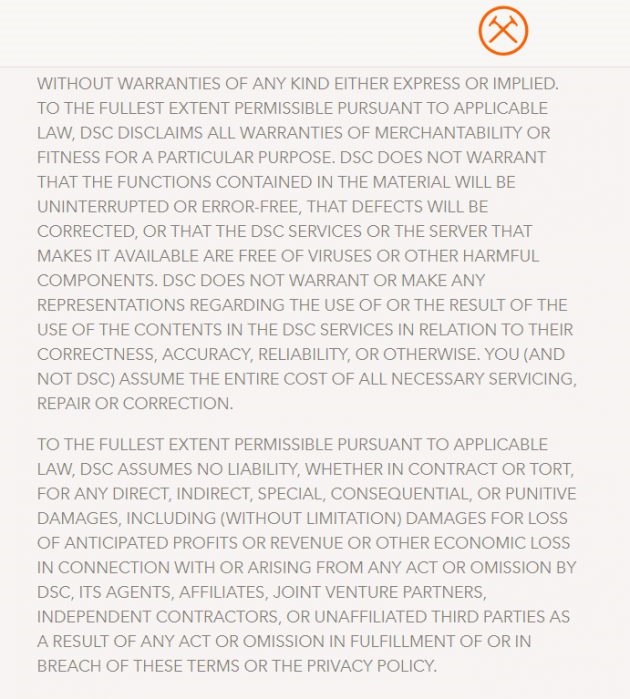
eCommerce Branding Strategy #8: Invest Big in Content Marketing
As we know, branding doesn’t start and end with your website copy and store design. Part of building a strong brand identity is meeting your customers where they are (digitally) and making a good first impression with value. Creating a diverse content plan goes a very long way towards this. Whether you’re a clothing store creating a value-packed podcast on fashion trends or a beauty store creating how-to video guides on the perfect markup applications, the possibilities are endless.
The key, here, is to have a good understanding of what pain points your potential customers have and create content that addresses them (in a format they prefer, on a platform they visit). Not to mention the added benefit of bringing more targeted traffic to your online store! An excellent example of an eCommerce brand winning at content marketing comes from our The 5 Best Ways to Increase eCommerce Traffic post.

Conscious Step does an excellent job of staying true to their message while creating relevant, regular blog content that’s easy to read and share. Meaning the topics appeal to their shoppers and are optimized so that the content is digestible and easy to pass along.
What to Do: Use Content Marketing to Boost Branding
Having a scalable content marketing plan is a big part of strengthening your brand. To do this, you want to define your content marketing objectives, invest in organization tactics, use content in various ways, automate, and watch the metrics!
eCommerce Branding Strategy #9: Prepare to Continuously Review, Reflect, and Refine
Lastly, you must implement the most effective eCommerce branding strategy of all: reviewing, reflecting, and refining. We have called these The Three Rs. Like with any aspect of your online store business, you want to continuously review your brand’s vision, value positioning, customer journey, copy, marketing, and trending topics. Your products can be amazing, but without good branding that makes your brand not only approachable but trustworthy, you’re not going to get customers through the digital door.
What to Do: Review, Reflect, and Refine
Continuously make sure your brand is speaking to your audience. To do that, you want to ensure you take customer feedback and data seriously, keep a close eye on your competitors and industry trends, invest a lot in customer experience and service, and ensure you are under-promising and over-delivering.
—
Final Thoughts
It’s important to note that branding is a long-term strategy. Ultimately, you should be building an identity that people are investing in. Because product types, variations, and trends may come and go, but your store brand – that’s forever. And that is where the profit potential is.
Have questions about these leading eCommerce branding strategies or creating a brand identity from scratch? Post them in the comment section below.
Digital & Social Articles on Business 2 Community
(63)

 Shop @yasminechanel’s ‘black faux leather turn up hem cigarette trousers’ (r9345621) + ‘black graphic lettuce hem crop top’ (tjf302673) on site now #missguided
Shop @yasminechanel’s ‘black faux leather turn up hem cigarette trousers’ (r9345621) + ‘black graphic lettuce hem crop top’ (tjf302673) on site now #missguided

